Menus
- Test of KTM Duke 125, 200, 390, 690, 690 R and 1290 Super Duke R
- A family that Thai its way
- KTM 125 ABS & 200 ABS
- KTM 390 ABS
- KTM 690 DUKE ABS & 690 DUKE R
- KTM 1290 R & 1290 Race Kit
- More info on KTM Duke
Test of KTM Duke 125, 200, 390, 690, 690 R and 1290 Super Duke R
With a 2014 record year in terms of sales, the Austrian manufacturer is inaugurating an unprecedented event on the Asian continent; Close to India where its small engines are produced in Bajaj, it is in Thailand that KTM invites us to a presentation of its most dynamic range: Duke and Super Duke. This geographical choice would result from the desire of the Orange Group to involve Europe in its globalization. It also allows KTM to assert, if necessary, its position and ambition in the road segment. Now, it has an R&D department separate from the offroad.
Doubling its sales between 2004 and 2014, for a total of 1.3 million vehicles, the number of road machines has also exceeded that of its offroad motorcycles this year! But the Mattighofen firm is not resting on its laurels, investing 85 million euros in research and development and extension of its premises. In addition, his 14th successive Dakar victory (Marc Coma) and the announcement by Stefan Pierer of his arrival in MotoGP in 2017, further energize the group. As a reminder, the brand is now present in 90 countries, recently integrating two essential luminaries: China and Brazil. There are more than 1,650 orange resellers scattered around the globe..
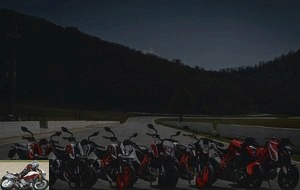
A family that Thai its way
Two decades of Duke and Super Duke are therefore celebrated by KTM, which brings together the entire current family and its latest optimizations 200 km from Bangkok. An off-road specialist, the Austrian manufacturer decided in 1994 to tackle the road segment. The very first Duke then appears, a vaguely civilized supermotard machine. Its version of 1998, Duke 2, aesthetically approached a street trail.
For the Duke range, everything accelerated in terms of style and ergonomics in 2007, with the design of the 690 Stunt concept by Kiska, head of style at KTM. This laid the important foundations for the image and future success of the range. Thus the lines of the plunging and wide sides (beginning of protection) and the shape of the saddle (rider "in" the motorcycle and no longer "on" it), definitively anchor the machines in the road range. It’s time for the Duke III (690). Aggressive styling borrowed from the sporty roadster, but intact KTM genetics. Single cylinder LC4, anti-dribble clutch and 3Kg less than its predecessor !
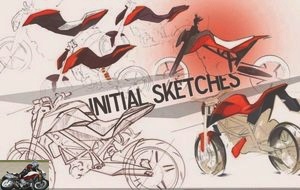
The success of this machine announces the arrival of a complete range. 2012 sees the appearance of the last born of the 690, model preceded by a 125, accompanied by a 200 and followed by a remarkable 390…. As Thomas KUTTRUF, Head of Press Relations, reminds us, "The more new products we offer, the more audiences we get and the more sales we make". It also highlights the excellent sales of KTM street bikes in Germany, even passing some Japanese manufacturers..
All this production shares a trellis frame and top-of-the-range equipment, allied to an expressive engine. Their unusual weight / power ratio makes them efficient and fun motorcycles. To test this sibling, it is in Kao Yai National Park and on the local Bonanza circuit where we go from our nearby place of stay, riding 200 ABS.
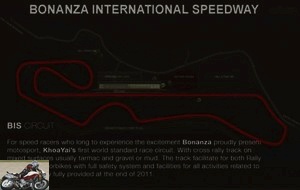
KTM 125 ABS & 200 ABS
Best-seller in Europe for the 125 Duke, sold at 22,000 units for the Duke 200, the two small stars share all their genetics and optimizations. For 2015, KTM improves their comfort, with redesigned saddles and new grips. That of the accelerator sees its rotation reduced by 77 °. A very significant development, which will now avoid "breaking" the wrist. In terms of durability, there are more resistant indicators as well as a new generator and fork seal.
Imported in France to a handful of copies and few in Europe (Greece), the fifth of a liter provides a much higher approval than that of the 125. More torque, it satisfies much better road use. Comparable in every way to its younger sister, only its beefier single-cylinder, 199.5 cm³, differentiates it. It has a bore / stroke ratio of 72 mm x 49 mm and develops 26 hp (19 kW) at 10,000 rpm and 19.5 Nm at 8,000 revolutions (against 15 hp and 12 Nm). And its weight is only 2.5 kg more…. or only 137.5 units. In use, these small differences in displacement make the machine otherwise able to tackle the road..
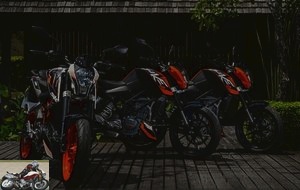
From 6000 revolutions, the uni-cylinder pleasantly animates the movements. Reversals and upgrades are negotiated over a wider engine range. The use of straight rubber, with its reduced stroke, significantly improves comfort. That of the seats is more relative, but we adapt to it on average journeys. 43mm inverted forks and lightweight swingarms add value to the small Duke. Their stroke of 150 mm and 130 for the shock absorber collects rather well the defects of the bitumen. The damping is sporty, but without affecting the general comfort of the machine. Note that the setting of this varies according to geographical distributions. More flexible in India, it will be braked better in Europe in order to better follow the characteristics of the road network.
The most remarkable thing is the extraordinary agility of these very light, narrow and rigid machines. A major asset for dynamic and exciting driving. Precise, they follow the trajectories that we have drawn with the eyes, passing from one angle to another without any inertia. The front axle provides a very good "road feel", bringing up all the necessary information. The Indian MRF Revz tires fit rather well for small Austrians, providing an acceptable grip.
Braking effectively, the Near Twins benefit from a four-piston radial front caliper, squeezing a 300mm single-disc. The opposite element is 230 mm, clamped by a two-piston pliers. But above all, the system is monitored by a Bosch 9MB ABS, which can be deactivated. Progressiveness and power allow you to calmly tackle all driving situations.
In the end, we regret that French legislation cannot authorize the A1 license to access this KTM RC 200. Both its approval, but also the safety it provides on the road with superior engine performance, more in line with traffic conditions. , make her attractive. Composed of high-end elements, their prices follow this positioning, the 125 Duke claiming € 4,100 and the 200 Duke € 4,480. This reduced gap will serve A2 license holders, which a more powerful machine does not attract. For others, we go to the next level ….
KTM 390 ABS
Economy of scale requires, the eldest of the small roadsters calls on the parts bank of her sisters. However, the first KTM motorcycle sold worldwide, the 390 Duke displays high mechanical specificities. Single cylinder with forged piston and Nikasil treated cylinder, the block weighs barely 36 kg. It develops 44 hp at 9,500 rpm and 35 Nm at 7,250 rpm. As a novelty, there is an anti-dribble clutch and a tire fitting in Pirelli Diablo Rosso 2. As for its sisters, redesigned saddle and new handles are on the menu, with there too reduced rotation of 77 ° for those of the gas. More resistant turn signals, new generator and fork seal complete the equipment.
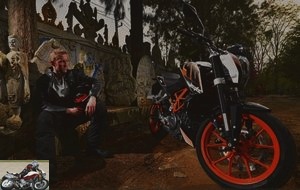
Le Repaire des Motards had made a circuit test of this KTM 390. Here, we take it on small roads, accompanied by big sisters twice as strong: 690 and 690 R. And it is clear that the seed of champion knows very well how to stand up to the elders, as soon as the road turns. Barely heavier than the 125 and 200 cc, the 390 rides its 147 kg with dynamism. Confusingly easy to place on the corner, it is piloted by intuition as the necessary supports are reduced. Its ultra-lively single-cylinder heart responds from 6,000 revolutions to release at 7,000 and up to the red zone, at 10,250 revolutions / minute. Of course, we knit the selector a little, but the will of this mechanism is amazing. And perfectly supported by a reactive cycle part, allowing to appreciate the new tires, fitting the rims of 110 and 150 inches. These gums provide excellent grip to the little fury.
To stop their rotation, we find the energetic equipment of the small Duke. The system is in no way overwhelmed by the surplus of force of the mono and always followed by the Bosch 9MB ABS. Similarity also for the WP suspensions of 43 mm and mono-shock absorber adjustable in preload. Although basic, these elements also provide a good feeling and correct comfort. The sport-typed seat is still pleasant on medium journeys. Its latest asset is a price just as incisive as its services: € 5,195.
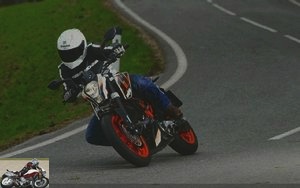
KTM 690 DUKE ABS & 690 DUKE R
The original road model of the manufacturer, "LA" Duke encapsulates the spirit of Mattighoffen in a sassy roadster. From now on, it is paired with a quasi-twin, decked out with an R particle and even more sophisticated equipment. The sisters have in common a racy aesthetic, dressed in sharp angles. Very small, these surfaces reveal the lattice structure of the machine, a sturdy 9 kg frame, in chromium-molybdenum steel. It supports the big 690 cc LC4 mono, more alive than ever. Producing 68 hp at 7,500 rpm and 70 Nm of torque at 5,500 rpm, this unit, unparalleled on the market, is equipped with the latest technologies. Dual ignition with individual mapping for each spark plug and a ride-by-wire system, electronic throttle valve control, optimize engine response and fuel consumption. And to cash in your sporty driving, an anti-dribble clutch will allow you to stack your reports at the end of the straight line, without surprise. Finally, the maintenance intervals are now extended to 10,000 km. A challenge for a single-cylinder with so many constraints, proving the mastery of KTM with this engine. Moreover, the Duke R receives a specially dedicated Akrapovic line, lighter, allowing it to spit two additional horses. The brushed stainless steel pre-silencer placed under the engine also contributes to mass centralization.
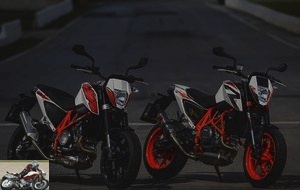
A compact headlight unit covers the 43mm inverted WP fork of the Duke. But here too, the machines differ a lot. Not adjustable as standard, the R’s equipment is much more advanced. Adjustable by compression wheels (top of the left tube) and rebound (top of the right tube), the damping is also calibrated more finely. The tubes raise the machine 15mm, gaining the same amount of travel. They take place in aluminum tees, anodized orange, the most beautiful effect, reinforcing the sporty style. Same treatment for the shock absorber, again raising the machine by 15 mm. We thus gain ground clearance. To the simple preload adjustment of the "basic" version, the R contrasts a separate hydraulic reservoir element, fully adjustable in preload, rebound and high / low speed compression. What to face the track and the road, with ambition.
The riding position follows this trend, gratifying the Duke R with an adjustable handlebar and set back footrests. Thus, the body tilts slightly more forward, ready to react to the demands of the circuits..

Especially since the braking follows the performance of the Duchesses. There are also important differences here. While the standard is already well endowed with a four-piston radial front caliper, the R has a dedicated Brembo radial master cylinder. The latter drives the new radial monobloc M50 front caliper (lighter and machined from a single piece of aluminum for optimum rigidity), four pistons. Combined with a 320 mm disc for the steering gear, 240 mm on the opposite side and a deactivatable Bosch 9M sport ABS, the 690 Duke does not amuse the terrain. Especially since a dongle (available as an option) enables Supermoto mode; the front wheel is then still controlled by the ABS to prevent it from jamming, but the rear wheel can slip or jam as the pilot wishes. And to complete the look, R purists will only have to install the passenger seat cowl and remove its footrests. They will also appreciate the parts specific to this model: to limit costs in the event of a fall, protective tubes surround the sidewalls and buffers at the ends of the wheel axles will preserve this expensive fork. More anecdotal, there is a transparent cover for the air box and the saddle is stitched orange. The latter is adjustable in height, offering 835mm and 865mm of altitude.
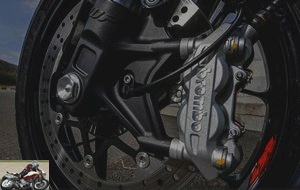
In use, we feel the differences between the two Duke very noticeably. A road trip immediately demonstrates the quality of the damping of the R, flying over the defects of the bitumen. Its sparkling mono-cylinder stirs with great vigor its only 164 kg fully loaded! This lightness goes hand in hand with the proverbial rigidity and narrowness of Austrian motorcycles. In expert hands, the 690 Duke R will show many more powerful machines in the narrow shell. The precision of its cycle part allows chiseled trajectories while the Duchess twirls from yaw to yaw, in a hardly formal waltz. His rise of Metzeler Sportec M7 RR in 120 and 160 is no stranger to it, riveting the KTM on asphalt.

Imperial on the angle, we greatly appreciate the finesse of its injection to keep and modulate the throttle smoothly. Only a certain propensity to vibrate, despite the presence of a balancing shaft, will be able to titillate those less familiar with this living mechanism..
This facility is found on the track where we take the R. Of course, we will not fight in a straight line with the missiles. But when the track turns, the Katoche becomes an extra toy. Its single-core, quick to climb the towers, catapults you with joy from 5,000 revolutions. It retains its efficiency until the edge of the red zone, around 9,000 rpm, providing excellent revivals. Its latest generation compounds effectively support the boldness of the LC4, but we will keep in mind the absence of anti-slip.
The Duke’s lightness is of course its major asset. Devoid of inertia when changing angles, perched on top-of-the-range suspensions, the Austrian reacts finely to each impulse, both on the handlebars and on the footrests. It is then very easy to adapt its trajectory if it requires it..
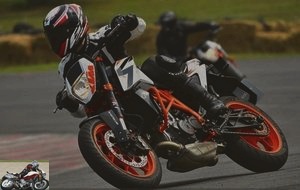
The Duke R will also put the brakes on your competitors of the day. Without possible comparison with that of its standard sister, its equipment gives it an excellent feeling on deceleration phases. Power, progressiveness, the caliper delivers natural and easy-to-dose braking. You can also keep the pressure on the lever in a curve, without hindering the steering gear in any way. A real racing and fun DNA governs this machine, letting its pilot lead the maneuver and concentrate on the essentials..
Fully accomplished, the 690 Duke is a connoisseur’s machine. The passionate R. Priced at € 7,850, the "simple" version still boasts flawless manufacturing. Claiming 10,200 €, its sport version seems almost cheaper as its high-end equipment boost da dynamics and its behavior. Appreciable on a daily basis, fun on demand, the two sisters are incorrigible savages. And know that these bombs are eligible for the A2 license ….
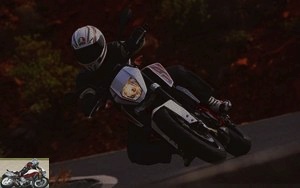
KTM 1290 R & 1290 Race Kit
Are you an ace of the curve, but tired of being dropped in the stretches by powerful hyper-sports? KTM offers you the best of its naked machines: the 1290 Super Duke R, known as "The Beast". From its first version in 2005, through the evolution in 2007 and the first R version in 2008, the kaïserin has never ceased to impress in the hyper roadster segment. The 690 Stunt concept also served this latest installment. Issued in 2013 and 8,000 copies have already sold, it lays new foundations in terms of excessiveness.

Starting with its 1,301 cc 75 ° V-twin delivering 180 hp at 8,870 rpm and above all 14.7 da.Nm of torque at almost mid-range (6,500 rpm)! From 2,500 revolutions / minute, 10 da.Nm activates the flight of the crew…. because the monster weighs less than 210 kg fully loaded, its block 62! Lightened forged pistons, Nikasil treated cylinder, four-valve cylinder heads with 2 ACT and double ignition, the twin LC8 offers mechanics at the very latest standard. All supported by an anti-dribble clutch, damping the pressure of the clutch discs when the engine’s counter torque becomes too high. Stack the gears under braking, the Super Duke does not care. And with reliability, KTM spacing interventions every 15,000 km !
Of course, the electronics are at the level of these performances. Gas management by a ride-by-wire control delivers optimized injection and allows a number of piloting aids. First of all, a choice of three engine maps, via a switch on the handlebars influencing the general behavior of the engine, the maximum power, but also the implementation of anti-slip (MTC). In “Street” and “Sport” mode, the engine deploys its full power of 180 hp and sport-style traction. “Rain” mode limits maximum power to 100 cannons, released more flexibly and traction control more intrusive. This lean angle sensitive MTC (Motorcycle Traction Control) system reduces engine power via the throttle valves. Depending on its adjustment, it allows different levels of rear wheel drift, particularly in "Sport" mode..
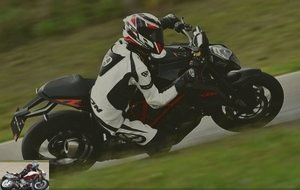
All this benefits from an uncompromising cycle part. The twin is housed in a robust and light trellis frame with thin walls (9.2 kg) receiving an aluminum single-sided swingarm. Its oscillations are entrusted to a WP mono-shock absorber adjustable in all directions. The steering gear is fitted with a respectable 48mm inverted WP fork, with separate compression (left tube) and rebound (right tube) adjustments. A steering damper comes to support it to curb the volcanic revival of the machine.
In order to slow down or stop the steed under hormones, we will use Brembo monobloc M50 front calipers, four pistons and radial mounting, like its master cylinder. 320 mm and 240 discs for the rear and the whole set under the yoke of a disconnectable Bosch 9M + sport ABS. The 17-inch rims are dressed in Dunlop SportSmart2 wraps in 120 and 180 with a road profile, but allowing the outings on circuits without too many moods.
This is how we set off again on the subtle layout of the Thai circuit. The expressiveness of the Super Duke is a pure delight, as is its ease of handling. Over the turns, the orange alchemy works at full capacity. Certainly, less easy than a hyper-sport, the KTM is docile and scrupulously follows the instructions of the pilot. Braking, focusing on the angle, exiting a curve, each phase is evident on its handlebars as the roadster gives you confidence. Highly available and barely rough, the V2 is easily managed thanks to a particularly precise electronic throttle control. The right handle / rear wheel link is natural and the plethora of livestock also seem well tamed. Outrageousness, this, but measured…. Clearly, efficiency, Austrian pragmatism requires. A notion that the anti-skating confirms, with a hardly noticeable implementation. This strong character, but exploitable is a real asset. Likewise, the LC8 block still shows amazing vigor beyond its peak of maximum power. We can therefore sometimes pull the gears to the limits of the red zone without losing any engine power..
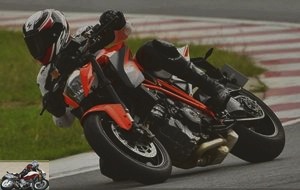
One of the rather bumpy curves of the route highlights the effective damping of the WP equipment. Firm, but still road, the general setting offers a correct sport / comfort compromise in each area. However, the fastest may feel a slight inertia on the sharp changes of angles. On the other hand, we keep the brakes on the angle without even anxiety. Progressive and powerful, the braking system allows the most powerful decelerations, with just one finger.
With this Super Duke R, you have enough to win your duels on the circuit. But if you’re looking to humiliate, KTM has an ultimate outfit: the Racing Kit. On the program: optimized and more responsive injection to follow the installation of a complete Akrapovic line. The whole thing gives no less than 13 additional hp, 5 Nm of torque and a few pounds less. A set of carbon parts further relieves the machine. But above all, it is a fork and a specific competition type shock absorber that sublimates the beast. It is raised by 15 mm on its new legs. The position of the footrests and the hanger are also adapted. Finally, a pair of Dunlop KR106 and KR 108 slick tires complete the equipment. These improvements were validated by in-house developer and former GP pilot Jeremy McWilliams.

So adorned, "The Beast" is ready to make you "The Best"! The vocals of the Super Duke R are simply impressive! By itself, without chicane (road approved silencer with DB killer), the exhaust throws you into the racing world. Perched on the machine, I go on the attack from the first turn. Even more reactive to the supports, the beautiful beast is also more reactive to the irregularities of the asphalt. Likewise, its competition tires generate more stress on its suspension during re-acceleration. The front axle moves more, but without discomfort, on the revivals, testifying to this observation. Less comfortable and less easy on damaged parts of the track, the Racing Kit version flies everywhere else. To appreciate it as it should, do not hesitate to increase the pace further, because the Austrian is waiting for that. Unfortunately, the circuit’s infrastructures did not give rise to unbridled optimism. Clearances too small, ditches…. we stayed on the reserve. A wisdom that the manufacturer will not take offense, this over-equipped machine flirting with 24 or 25,000 €…. (no precise figures for the moment). Suspensions alone are worth more than 6,500 €.
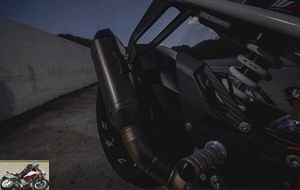
As a reminder, the standard version charges € 15,995. Its efficient mechanical personality and electronics which is no less so give it many arguments against the bad guys in the segment. We can mention the captivating Aprilia Tuono V4 R APRC ABS, also superbly equipped, at the tempting price of 13,999 €. And the BMW S 1000 R, 13,250 €, is no exception in terms of equipment. To these challengers, the Super Duke R opposes an uncompromising sport philosophy.

The spearhead of the Austrian brand, it sits at the top of its road range, testifying to the manufacturer’s profound evolution. Indispensable outside of bitumen, KTM is now just as much on asphalt, with a production that guarantees its original DNA, both aesthetic and mechanical. Beautiful work.
More info on KTM Duke
- The technical sheet of the KTM Duke 125
- The technical sheet of the KTM Duke 200
- The technical sheet of the KTM Duke 390
- The technical sheet of the KTM Duke 690
- The technical sheet of the KTM 1290 Super Duke R
Related articles
-
At maturity If the Duke 3 was an exotic outsider against classic roadsters, this fourth generation largely deserves its place in the family and is a…
-
Versys 300 and 650, Vulcan, Ninja 400 and 650, Z650 and Z900, from 300 to 900, from 5,000 to 9,000 €, 7 machines for the new A2 licenses Trail, sport,…
-
Ducati Hypermotard 950 and SP motorcycle comparison test
The art of irreverence L-Twin of 937 cm3, 114 hp and 9.8 mkg, 200 kg full made, from 12,690 euros What is a Hypermot ‘? If we say it’s a mix of supermot…
-
Comparison test for KTM 690 SMC-R and Enduro R motorcycles
Mono multi-pleasures Single cylinder LC4, 690 cm, 74 hp and 73.5 Nm, WP suspensions, Brembo brakes, 10,799 euros The very DNA of the brand, the…
-
Light is Right ! The little Duke 390 is an amazing machine. Ultra light and very powerful without being radical, it comes to hunt on the lands of the…
-
KTM 790 Adventure and Adventure R motorcycle comparison test
New icon, Easy Adventure 95 hp at 8,000 rpm and 89 Nm at 6,600 rpm KTM, it was the master of the single cylinder, then of the maxi trail but was absent…
-
Comparison test Triumph Tiger 900 GT Pro and Rally Pro
Annexation of new territories 3 cylinders in line, 888 cm3, 95.2 hp, 87 Nm, 198 kg and 201 kg, euros Although the creative nation of rugby, the English…
-
Ducati Multistrada range comparison
From 950 to 1200, from 113 to 152 hp, from 13,890 € to 23,390 € A close match to find the best proposition of the range… The big trail is in fashion:…
-
Vintage 2019! Even better than before ! V-Twin LC8 а 75 °, 1.301 cm3, 175 hp and 141 Nm, 209 kg, semi-active suspensions WP Happy New Year for KTM which…
-
Honda CB500F, CB500X and CBR500R comparison test
Three-variable equation, proof by X A roadster, a sports car and a trail, 3 possibilities 500 Two boys, a girl … a roadster, a sportswoman, a trail,…